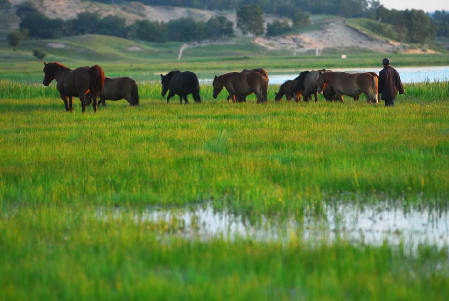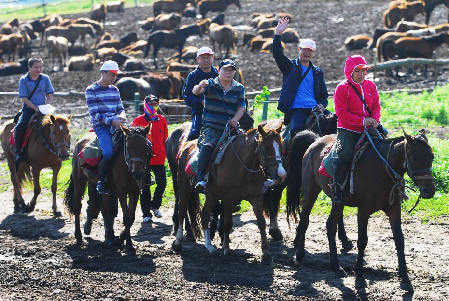Imperial Mulan Hunting Ground
THE imperial Mulan hunting ground is located at the junction of Hebei Province and Inner Mongolia Autonomous Region. Many tourists call it “Bashang.” Originally, the Chinese word Bashang meant a plateau covered with meadow and green pastures. Today, Bashang especially refers to several grassland areas located in Zhangjiakou, Chengde, and Chifeng. The Bashang Grasslands comprise four parts: Zhangbei Bashang, Fengning Bashang, Guyuan Bashang, and Weichang Bashang, located in four different counties in Hebei Province. Among them the Weichang Bashang (Weichang in Chinese means hunting ground) is the most beautiful.
The Mulan hunting ground is located at an altitude of between 1,400 and 1,600 meters. The plateau belongs to a cold temperate zone and features a continental monsoon climate. The winter here is long and cold, but the summer is cool and pleasant. In July, while northern China is under intense heat, the average temperature in Mulan remains around 24 degrees centigrade; thick blankets are necessary at night. The Mulan hunting ground comprises meadows, forests, lakes, wetlands, and valleys, making it another good choice for a summer resort. In recent years, its reputation has exceeded that of the popular Chengde Mountain Resort. Also, because it is the nearest grassland to Beijing, many Beijingers consider Mulan the “back garden of the capital.”
 |
| A herdsman and his horses by Jiangjun Paozi Lake. |
Vast Prairie Dotted with Cows and Sheep
The distance between Beijing and the core area of Mulan is about 450 kilometers, a surprisingly pleasant seven-hour drive. Fresh air and a cool breeze greet you as you arrive at Chengde City, and when you get to the Mulan hunting ground you find yourself transported to a completely different world from that of mega cities full of skyscrapers. You can also take the train from Beijing to Chengde or Siheyong, and a bus directly to the Mulan hunting ground.
The Mulan hunting ground is divided into two parts: the Saihanba National Forest Park in Hebei Province and the Ulan Butong Grassland in Inner Mongolia Autonomous Region. The Saihanba is the largest forest park in northern China. Its total area is 1.41 million mu (94 hectares), two thirds of which are covered in immense forests. The Ulan Butong features a lush grassland landscape. If you are driving, you can first visit the Saihanba park, and then cross the bridge that serves as a border between Hebei and Inner Mongolia to arrive at the Ulan Butong Grassland.
Most travelers choose to stay near the Hongshan Military Stud Farm. Thanks to almost 10 years of development, this place is geared to tourists, so has ample hotels and inns. However, during the busy midsummer season, it is still difficult to find a room or a bed, so advanced booking is advised.
Mo Binxu, editor of a travel website in Beijing, went to the Mulan hunting ground for the first time during the summer of 2011. Of the many scenic spots around China that her job has taken her to, the vast pastures of the Mulan hunting ground amazed her. The poetic scenery includes a white birch forest on the northern side of the mountains, which are dotted with groups of cows and sheep.
As evening approaches, photography lovers flock to Jiangjun Paozi to capture the gorgeous sunset. Paozi means “lake in the meadow.” The Mulan hunting ground is where the Yinhe River and Tuligen River originate. Therefore, lakes are scattered all over like stars in the sky. The Qixing (seven stars) Lake, Gongzhu (princess) Lake, and Yueliang (moon) Lake are other attractions in the area.
 |
| Tourists enjoy the grassland on horse back. |
Yesterday and Today
The beauty of the Mulan hunting ground has a long history. It became an imperial hunting ground and summer resort in the Liao Dynasty (907-1125). By the time of the reign of Emperor Kangxi (1662-1722) of the Qing Dynasty (1644-1911), the area, which spans over 14,000 square kilometers, was designated as the imperial hunting ground, the largest ever.
When the hunt began, cavalrymen would gather in a circle to identify an area on the meadow. Then, soldiers, hiding in the woods and wearing deer masks, would blow long wooden horns to imitate the sounds of rutting stags. Deer would be attracted, followed by predatory animals too. The cavalrymen then would gradually close in. The privilege of launching the first shoot belonged, of course, to the emperor, followed by his sons and grandsons. Finally, other members of the imperial dynasty, ministers and nobles would join in the large scale hunt.
In the Chengde Mountain Resort Museum, hangs a painting titled Emperor Qianlong Hunting in Mulan, which vividly depicts the grand scene at the hunting ground. Each hunt lasted 20-odd days. After the hunt concluded, a grand banquet would be held, during which the emperor would invite his ministers to drink and enjoy singing and dancing performances. He would then reward them according to their military exploits.
The emperors of the Qing Dynasty (1644-1911) enclosed this piece of land not only for recreational purposes but also political reasons. The Mulan hunting ground is located between the capital city of Beijing and Mongolia, and therefore occupies an important strategic position. The hunts organized by the Qing emperors thus also served as military exercises. In 1690, Emperor Kangxi won the Battle of Ulan Butong and crushed the rebellion of a Mongolian tribal leader Galdan. In the following century, Emperors Kangxi, Qianlong, and Jiaqing launched as many as 105 hunts.
Today, the hunting ground is no longer a field of military confrontation. People of different ethnic groups have settled here and developed the local tourist industry. They cherish the nature’s bounty and develop activities for tourists to best experience local customs and the culture of the grassland. During the daytime, you can ride horses, go kart, and paraglide. In the evening, you can stay with local families, eat roast mutton, enjoy fresh air, and gaze at the stars.
A Paradise for Photographers
For photographers, the Mulan hunting ground is a true paradise. Whether in summer, autumn, or winter, there is always a good shot to be captured here: vast green grasslands in summer, golden birch forests in autumn, snow-capped mountains in winter. Each view is unique and breathtaking.
Zhang Shuwen, a local from the Mulan hunting ground, formerly ran a guesthouse near the Hongshan Military Stud Farm, where he made the acquaintance of visiting photographers. Since 2008, he has been a photography lover too and began work as a tour guide exclusively for photographers. For the past few years, Zhang has accumulated a number of impressive shots. Nicknamed “Bashang Old Zhang,” Zhang Shuwen is now well known among photographer bloggers.
Every day, Zhang takes professional and amateur photographers to visit the surrounding sites to take pictures. Zhang loves his hometown and knows all the sites with the best views.
In fact, the Mulan hunting ground has gained in popularity thanks to the efforts of the first batch of photographers who came to Mulan over 10 years ago. Today, more and more locals are starting to work as tour guides for photographers and they are using the medium of photography to showcase the beauty of their homeland to the outside world. Azure skies, green meadows, rolling hills, and thick forests change their colors in different seasons, making Mulan a paradise for photographers from all over the country, throughout the year.
